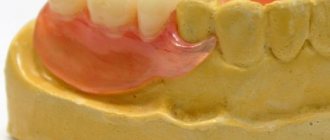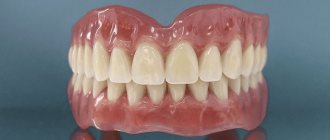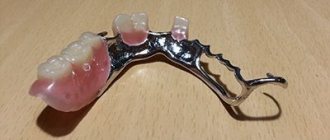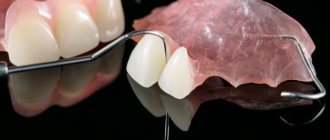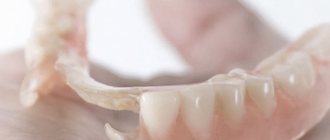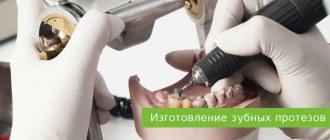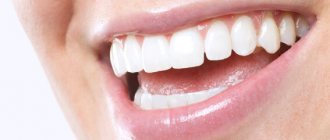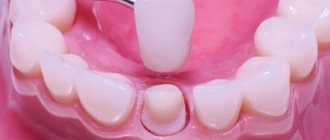- Indications
- Contraindications
- Advantages and disadvantages
- Kinds
- Clasp
- Made from nylon
- Lamellar
- Immediate dentures
- Manufacturing and installation
- Rehabilitation
- Care
- Prices
- Work examples
- Doctors
- Reviews
Despite the variety of implants, crowns and other methods of dental reconstruction, removable prosthetics does not lose demand, remaining an option for patients. Lightweight and strong structures compete with permanent dentures. This is a choice in cases where the patient cannot undergo implantation or have a fixed orthopedic system installed.
- When used:
missing from 1 tooth to completely edentulous - Type of anesthesia:
no need - Procedure time:
from 30 minutes (up to 4 visits) - Treatment period:
from 1.5 weeks to 3 weeks - Healing period:
from 3 weeks after the last removal - Age restrictions:
from 18 years old (in our clinic)
What dentures are best?
The type of system is selected individually. Taking into account the pros and cons of the designs, we draw the following conclusions:
- In case of partial loss of teeth and the presence of supporting teeth, clasp dentures will be an option. If there is an allergy to metals, choose QuattroTi dentures, acrylic, nylon models.
- If you have a toothless jaw, intolerance to acrylic and the impossibility of implantation, use plate Acry Free or nylon analogues.
Clasp dentures from 40,000 rub.
Nylon prostheses from 40,000 rub.
Lamellar dentures from 32,000 rub.
Butterfly prosthesis from 11,000 rub.
Quadrotti prosthesis from 64,500 rub.
Acri-Free prostheses from 47,000 rub.
Even with the same dental defects in two patients, prosthetics proceed differently. Only a doctor can tell which orthopedic product is the decision in this clinical situation, after examination and x-rays.
YOUR QUESTIONS AND ANSWERS
QUESTION: Is it possible to make a new tooth if only one root remains from the old one? Or in such a situation, just remove the remains? Gera
ANSWER: If the root is preserved, then the tooth can be restored. There may be several options: use a pin or stump inlay for extension, followed by restoration of the supragingival part. The choice of method depends on the initial situation, so you can definitely say which one is suitable in your case after examining and taking a photo of the tooth.
QUESTION: After prosthetics for both jaws, I developed a problem in my upper jaw. I made a puller, the lower jaw fits well, but the upper jaw puts a lot of pressure on the attachment points. When I take off the prosthesis, the pain does not go away for another two days. I went to the doctor to have him loosen it, and now the prosthesis is falling off. Cornet
ANSWER: Dear Cornet, we are very sorry for your situation! First of all, it is important to understand that when installing removable structures, if you have not worn them before, there is an adaptation period. And in many cases it can be quite long and takes 2-3 months. During this time, you need to take out your removable denture only for cleaning after meals, but try to wear it the rest of the time so that the oral cavity adapts. In your situation, the compression of the gums at the attachment site could have been eased slightly, and over time the tissue would have gotten used to it. After the correction, the prosthesis began to fall out, perhaps due to the fact that the specialist was overzealous and removed a little more than necessary. Unfortunately, it is impossible to return the former boundaries of a removable denture - only to make a new one. Alternatively, you can try a special adhesive denture adhesive to improve bonding. It can be bought at a pharmacy.
1Belousov N.N. Time and sequence of stages of complex treatment of inflammatory periodontal diseases // Periodontology. – 2007. 2Razumnaya Z.V. Improving the technology of manufacturing dentures using CAD/CAM systems, 2012.
Author: Chorny S.V. (Thank you for your help in writing the article and the information provided)
Advantages and disadvantages
Advantages
- Restoring the aesthetics and functioning of the dentition;
- used in complex clinical situations when reconstruction methods are impossible;
- selection of types of orthopedic products;
- installation without preliminary grinding of abutment teeth;
- variability of materials for manufacturing;
- without restrictions;
- speed of production and installation;
- repair of the orthopedic system in case of mechanical damage;
- ease of wearing and care;
- exceptional hygiene and safety;
- no age restrictions;
- use as a temporary prosthetic structure;
- service life (5-8 years);
- preservation of aesthetic indicators;
- price.
Flaws
- Restoration of chewing function is not complete;
- changes in diction, taste sensitivity during the period of adaptation;
- the likelihood of gum inflammation, irritation of the oral mucosa;
- uneven distribution of chewing loads;
- unable to stop or prevent jawbone atrophy;
- not all types of dentures and fixtures can be repaired;
- risk of damage to tooth enamel, development of cervical caries in the area where the attachments adhere to the supporting ones;
- relatively long period of adaptation;
- deformation and subsidence of the product (for metal-free structures);
- insufficient fastening on the lower jaw (applies to complete removable dentures).
Creation and installation of various prostheses: what are the stages and how long will it take?
Article navigation
- Stages of prosthetics
- - reorganization
- — photometry
- - casts
- - choice of prosthesis model
- — design and planning
- — creation of a prosthesis
- - first fitting
- — fixation of the structure
- - education
- How long does it take for production?
- Manufacturing time for fixed dentures
- Production time for removable devices
- Care
- QUESTIONS
Question for a specialist
Modern dental prosthetics are affordable and multivariate solutions for restoring the aesthetics of a smile and the function of chewing. In preparation for restoration, the patient goes through several preparatory stages, which include choosing a doctor and clinic, selecting a prosthetic technique and preliminary treatment - they can take from a couple of days to several months. Detailed materials about this can be found on our website. The creation and installation of structures also consist of various procedures. What stages are involved in direct dental prosthetics, and in what time frames the structures are made, we will describe in detail in this article.
Types of removable denture systems
Removable dentures – orthopedic products. They are removed and installed in the oral cavity independently. Dentures are made from biocompatible, elastic materials. Two kinds:
- Partial removable - installed if the patient is missing one or more in a row. These are plate, clasp, and immediate dentures. They are attached to supporting teeth or implants with fixing elements. Evenly distribute the load when chewing between the supports and gums.
- Full removable – in case of loss of teeth on one or both jaws. In such situations, it is impossible to secure the denture to a rigid support. Alternative fixation is used. The chewing load is placed on the gums.
Modern technologies provide strong fixation and precise fit to removable orthopedic systems. Patients note the ease of use and care.
Technique for making removable dentures
Poor chewing of food due to missing teeth can impair the functioning of the gastrointestinal tract. In some cases, the only way to restore chewing function, which is extremely important for maintaining health, and to regain a beautiful smile, is to make removable dentures. technology protects the jaws from further destruction. The manufacture of removable dentures is carried out in cases where natural teeth for some reason could not be preserved. Removable prosthetic structures are attached to the jaw due to the ability to stick to it. They have the shape of curved plates on which artificial teeth are installed. The shape and color of the teeth are selected according to the individual needs and wishes of the patient. The color of a removable denture is as close to natural as possible. How are removable dentures made today? The technology of making dentures has now reached a level that far exceeds that of the recent past. Modern production of dentures is based on the use of new technologies and materials. Thanks to the successes that dentistry has achieved to date , removable dentures have high strength characteristics, aesthetic properties and hygienic qualities. Removable prosthetic structures have no age restrictions, and their manufacture takes into account the individual characteristics of the patient’s jaws, thereby minimizing discomfort when using them. Of course, dentures should not cause discomfort in the mouth. For this reason, dentists advise not to remove them for the first time after installation, so you can monitor the human body’s reaction to them and make adjustments if necessary.
Clasp dentures
Clasp dentures are orthopedic structures made of artificial teeth on a base replicating natural gums, fixed on a durable metal arch (clasp). They correctly distribute the load when chewing without overloading the dental system. The condition for installing a clasp structure is a sufficient number of supports (teeth or implants) to which it is attached with hooks or clasps.
Types of fixed prostheses
This group is united by one condition - the patient cannot remove them on his own. This includes crowns, bridges, implant crowns, veneers and inlays.
Bridges They can be made of various materials - metal alloys, metal-ceramics, metal-plastic, metal-free ceramics, porcelain, plastic.
Fixed prosthetics of the teeth of the lower jaw are indicated for various defects, from single defects to total restoration, provided there is a sufficient number of supports.
All-metal structures do not have an aesthetic appearance, but are durable, but recently they are used less and less, due to the emergence of more modern and aesthetic types. In most cases, they are made to restore the lateral group of teeth. Metal-free dentures are very beautiful and have a natural appearance, but are quite fragile and are mainly used in the frontal area to improve aesthetics. Combined structures, especially metal-ceramic ones, are one of the most popular, as they are just as aesthetically pleasing as non-metal ones, but are also strong and durable.
Crowns cover the decayed portion of the tooth and restore its chewing efficiency. They can be single or welded together with nearby destroyed supports. Bridges replace included defects in the dentition, which means that they are fixed on supports that limit the defect on both sides. Both types of structures are attached using special dental cement.
Restoration of a partially destroyed tooth can be carried out using inlays and veneers. They are used in cases where cavity filling is not effective enough or is not aesthetically pleasing. The inlays fill the previously prepared cavity of the coronal part and are fixed with dental cement. Veneers can completely change your smile, as they can be used to correct the shape, color and even size of one or all teeth. They cover the frontal (front) surface, which was previously slightly prepared.
Removable dentures made of nylon
A base made of thin, elastic nylon on which artificial dental crowns are attached. Products are manufactured based on the clinical situation.
- The bioinert material does not contain metal impurities and does not cause allergies
, so the structures are not removed at night. - Since the color of the base is matched to the natural shade of the gums, the design is not noticeable and looks natural
.
Among the advantages are price, speed of adaptation, convenience. The only drawback of the design is that soft nylon sags and becomes deformed. But even so, the service life is 5-8 years
.
Fixed dentures:
Fixed dentures allow you to achieve high aesthetic and functional results. These dentures are the most comfortable and after a short time patients perceive them as their own teeth. Caring for these dentures is practically no different from your own teeth.
Fixed dentures include
- microprostheses: inlays, veneers, lumineers, these are prostheses that allow you to replace part of the crown of a tooth in order to restore it or improve the aesthetics of the tooth. For the manufacture of these prostheses, pressed ceramics are used, from which the frame is made and ceramic mass is applied on top
- crowns: this is a highly aesthetic and fully functional design that allows you to completely restore the coronal part of the tooth. And if it is necessary to improve aesthetics, change the shape of the tooth crown. These prosthetics include crowns and bridges on your teeth and on implants. If the tooth is destroyed by more than ⅔, then pin-stump inlays are made to restore the missing volume of tissue. They are made from cobalt-chromium alloy or zirconium dioxide
The materials for the manufacture of crowns and bridges are metals: cobalt-chromium alloys, nickel-chrome alloys, titanium, gold. Metal-free materials are also used: zirconium dioxide, pressed ceramics, feldspar.
Metal-ceramic crowns
- These are crowns consisting of a cast or milled metal cap and ceramic mass. After applying the ceramic, the crowns are baked in special vacuum ovens at temperatures up to 1000°C. These dentures completely imitate your teeth. They are durable and comfortable. The patient quickly gets used to them and begins to perceive them as his own teeth. The color of the future crown is selected according to the color of the patient’s teeth, so that they do not differ from their own teeth. There are a number of disadvantages to these crowns: they are not suitable for patients with allergies to metals. Over time, the edge of the crown near the gum begins to darken and this indicates oxidation of the metal; the edge of the gum adjacent to the crown may turn dark. There is also one nuance with aesthetics. If the patient does not have transparent enamel, then metal ceramics are ideal. But if the enamel is transparent, then the crown will stand out from the rest of the teeth. This is due to the fact that the technician, trying to hide the metal cap under the ceramic, applies non-transparent layers in the lower third of the crown, and when its thickness at the edge is less than a millimeter, the ceramic layer turns out to be thin and not transparent. The ability of such a crown to transmit light in the lower third is significantly different from its teeth and the tooth appears dull, not alive. Such crowns can be placed on chewing teeth where aesthetics can be neglected in favor of savings. It is better to place crowns of a higher class on the front teeth.
Crowns based on zirconium dioxide.
These crowns are precisely the next step in the evolution of orthopedic dentistry. In these crowns, the material used to make the cap is not metal, but the mineral zirconium dioxide. And it is also applied on top with ceramic mass and fired in a kiln. But, unlike the metal cap, it is transparent. And it can be given whatever color is needed to completely imitate the internal structure of the patient’s teeth. Since zirconium dioxide does not need to be hidden, the technician applies layers of ceramics that are as close as possible in terms of light transmission to the patient’s enamel and dentin. And as a result, we get a fantastic imitation of a living crown that is no different from the patient’s other teeth. In addition, such crowns are devoid of other disadvantages of metal-ceramics. Zirconium dioxide does not oxidize and does not darken along the edge even after 15 years. Previously, such crowns were made only abroad and cost exorbitant amounts of money. Since the technology for milling zirconium caps and bridge frames is quite complex and is produced using expensive equipment. Now all this exists in Russia. The prices for these crowns have become much more affordable and they cost slightly more than metal-ceramics.
Plate dentures
A group of prosthetic systems for partial or complete restoration. The basis of the structures is a soft base that imitates part of the oral mucosa, with artificial tooth crowns attached to it. Representatives of this group of orthopedic products are structures made from acrylic-free plastic alloy “Acry Free” and the elastic QuattroTi prosthesis.
- Partially removable QuattroTi
is an orthopedic system manufactured using 3D modeling technology. The approach ensures the fit of the structure and comfort of wearing. Elastic hook retainers do not require grinding of the supporting teeth, are invisible, and harmless to tooth enamel. - Lightweight, flexible Acry Free
made from non-allergenic composites combine appearance and comfort with service life (5 years) and price. Used for partial or complete restoration. The advantage of an orthopedic system is the ability to repair if damaged.
Made from bioinert materials, the flexible, soft base is not paintable and does not change color during service. They have a number of disadvantages, like similar orthopedic products.
Materials for the manufacture of removable dentures
The main requirements for the materials from which removable dentures are made are non-toxicity and the ability to look natural. A number of materials are used for these purposes, including:
- acrylic;
- plastic;
- zirconium;
- nylon;
- pressed ceramics;
- silicone;
- polyurethane;
- metal ceramics;
- clasp.
Based on what kind of material is used to create removable dentures, they receive certain properties. For example, the advantages of products made from metal ceramics and acrylic are strength and attractive appearance, while the advantage of products made from polyurethane and nylon is their flexibility. As for the shape and color of removable dentures, in all cases they are determined individually. Modern technologies provide the opportunity to create products with high aesthetic properties. Each of the listed materials has its own advantages and disadvantages. Therefore, when choosing, it is necessary to take into account the characteristics of each material and its suitability to your own needs. In solving this problem, recommendations from dentists can be of significant help.
Category Dentures Posted by admin
Immediate dentures
Removable immediate dentures - to replace defects in the dentition during the production of a permanent orthopedic system. There are three types of such models - full, partial, butterfly.
They cope with the task, return partial work to a lost dental unit and hide a visual defect. The disadvantages include fragility, fragility, and long addiction.
Patient reviews about removable dentures
Patient reviews of dentures, fully or partially removable, fixed, installed on implants, etc. depend on how well a particular method meets the person’s expectations and financial capabilities. The higher the cost of the design, the higher the expectations for their quality and wearing comfort, as a rule. However, in any case, restoration of the dentition and full chewing function evokes positive emotions, which means that the reviews are mostly good. True, for the sake of objectivity, it should be noted that the period of adaptation (especially with completely removable dentures) can leave a feeling of discomfort and foreignness of artificial teeth, which will soon pass. Reviews are also influenced by the level of professionalism of the orthopedic dentist and the accuracy of manufacturing.
Manufacturing and installation of a prosthesis
Includes stages:
- Preparatory and diagnostic – after hygienic cleaning, treatment, the patient undergoes a survey x-ray, CT scan of the jaw, which requires prosthetics.
- The dentist takes an impression and sends it to a dental laboratory.
- The production of an orthopedic system lasts on average 2 weeks. New technologies for taking impressions and 3D modeling make it possible to create anatomically verified structures that reproduce the chewing surface of each element down to the smallest detail.
- The doctor tries on the finished denture for the patient and corrects any discrepancies.
The final stage is fixation of the product in the oral cavity.
What designs are used in prosthetics?
In dentistry, various types of prosthetic structures are used, which can be divided into two large groups:
- Fixed: inlays and veneers (microprostheses), dental crowns, bridges and implants. They are used to replace defects in the absence of 1-4 teeth (implants can be used to replace any number of teeth, including those with complete edentia), as well as to restore damaged teeth with intact roots. They are fixed in such a way that only a specialist can remove them.
- Removable: the patient can remove such structures and then install them back on their own. They are used in cases where fixed prosthetics are contraindicated, as well as in the absence of a large number of dental units. The main support of such structures is the gums; they can also partially rest on the teeth remaining in the oral cavity.
Fixation of prostheses
Bugel, partial and full plate systems are attached to the mouth in different ways. Clasp ones are held in place with the help of clasps and attachments, partial plate ones - with soft fasteners, full plate ones - with a vacuum effect.
- Clasps
are metal hooks with which the prosthetic system clings to the base of the support units. - Attachments
are locks made of two components. One component is located on the prosthetic structure. The second is on the supporting tooth or implant. When putting on the orthopedic system, the clasp snaps tightly into place, holding the product in the mouth. - Vacuum effect
- flexible material fits closely to the gums and sticks to them. If necessary, increase the tightness of the seal, use “adhesive” pastes and gels.
Removable dentures are created using impressions from the patient. They are fixed in the mouth and do not fall out when chewing or playing sports.
Alekperov Roman Borisovich Dentist-orthopedist, doctor of the highest category
Is it necessary to remove a single tooth when performing removable dentures?
When talking about removable dental prosthetics of the lower jaw, they try to preserve their own teeth as much as possible. When replacing dentures in the upper jaw, single teeth must be removed. The decision is made by the doctor based on the clinical situation, after examination and diagnostic measures.
Alekperov Roman Borisovich Dentist-orthopedist, doctor of the highest category
There is only one tooth left on the upper jaw. Which denture should I choose so that the structure is held as tightly as possible and does not fall off?
If there is a single tooth in the upper jaw, only a partial, removable plate prosthetic system is likely to be manufactured. But such a design will not hold very firmly and in terms of reliability of fixation it is significantly inferior to prosthetics on implants. As an alternative, we recommend All-on-4, in which the denture is securely fixed to the jaw using only 4 titanium supports.
Alekperov Roman Borisovich Dentist-orthopedist, doctor of the highest category
On the left side of the upper jaw, 4 teeth in a row were lost. There are gold crowns on the lower jaw. Which removable denture is best placed on the upper jaw so that it does not conflict with the crowns?
In this case, it is possible to manufacture a partial removable lamellar denture based on acrylic or an Akri Free prosthesis. It is also possible to install the prosthesis on attachments or telescopic crowns. Since metal crowns are already present in the oral cavity, the best option would be Akri Free prosthetics.
How to install prostheses - stages of prosthetics
After the patient has been diagnosed and is fully prepared, prosthetic procedures begin, which will result in the restoration of lost teeth and a smile transformation. All of them are painless and do not take much time. Below is a description of all stages of dental prosthetics.
Sanitation of the oral cavity
It is a mandatory preparatory stage before prosthetics. Sanitation aims to improve the overall health of the oral cavity and reduce the bacterial load. It includes treatment of living teeth from carious lesions, elimination of inflammatory gum diseases, if necessary, depulpation - removal of the nerve from the tooth, canal filling, as well as a complex of professional hygiene. All this is necessary to create favorable conditions1 before future prosthetics.
%akc61%
For more information about dental treatment before installing dentures, read the article “Preparation for dentures: steps and procedures for successful dental restoration and long-term denture service.”
Photometry
A series of photographs of the patient's face and jaw are taken from different angles. The photo captures the patient's face with and without a smile, with jaws closed, in a relaxed state and with an open mouth. This is necessary to visually assess changes in occlusion, facial symmetry caused by missing teeth, as well as to record the patient’s “before” appearance. Later, the final result of the prosthetics will also be recorded in the photo and will determine the “after” result.
Taking impressions of the jaws
To create an accurate design, first complete impressions of the upper and lower jaw with the defect area are formed on a special pliable mass. If teeth are restored with complete edentia, then impressions of the gums are made. With their help, the base of the prosthesis and the structure itself are formed, taking into account the bite. For this purpose, devices such as analyzers and face bows are needed. They help to identify the parameters of bite and jaw closure - occlusion, which is of great importance for functionality and organic integration of the structure into the oral cavity.
This way, all the anatomical features of the patient will be taken into account - they are unique for each person. The impressions are sent to a dental laboratory, where a dental technician will evaluate the features of the prosthetic bed, the location of the defect, and take into account the shape and size of adjacent teeth.
Choosing a prosthesis model, teeth shape and color
Based on the diagnostic results, the doctor advises the patient several prosthetic options suitable for his clinical case. The shape and color of the teeth are immediately selected, harmoniously combined with facial features and skin tone. The choice can be made using special palettes, where possible options are presented, or on the monitor screen (if provided) - that is, in digital format. For example, through special software - we will discuss it below.
Digital Design and Planning
Some modern clinics, which have advanced methods of planning and creating dentures, offer their patients to see their future smile in advance and finally decide on their choice. For this purpose, digital smile design technology is used – Digital Smile Design. It allows, based on computed tomography data, to take into account all the anatomical nuances of the patient’s oral cavity even before making the prosthesis and create an artificial structure indistinguishable from natural teeth.
Thanks to the ideal selection of the shape of the teeth and jaw as a whole, taking into account the relationship and proportions of the face, the patient will receive an individually designed prosthesis. The principles of the “golden ratio” and “beauty mask”, embedded in computer modeling, allow you to correct your smile, creating truly harmonious and natural designs.
Creating a prosthesis in a dental laboratory
In the dental laboratory, the impressions obtained are transferred to plaster models - exact copies of the patient's jaws. And on their basis, with the help of special equipment and from various materials, prosthetics are already created. It is possible to manufacture a structure from both acrylic and expensive and durable zirconium dioxide using robotic equipment. It all depends on the type of prosthesis and its purpose.
The construction is manufactured by a dental technician, and an orthopedic surgeon controls the production process, monitors the quality of the parts produced, the accuracy of the transferred parameters and the convenience of future structures.
Today, the equipment of advanced dental laboratories allows us to produce both comfortable removable dentures, as well as crowns, bridges, and complete fixed appliances secured to implants. Most of them are created not manually, but using robotic equipment, including high-precision milling machines, CAD/CAM systems2, high-tech software, 3D printers, high-temperature ovens and more.
REPROSTHETOSIS WITH ACRYLIC PROSTHETICS - RUB 180,000!
Re-prosthetics with an acrylic bridge on a metal frame (all included) up to 12 units.
Call now or request a call
Read about new technologies that can speed up the production of dentures and significantly improve their quality in the article “New technologies and prospects for the development of dental prosthetics.”
First fitting and correction if necessary
To finally ensure the accuracy of the manufactured restoration and its convenience for the patient, the first fitting is carried out. The position of the structure in the mouth is not always comfortable the first time. The doctor can correct the design right on the spot or, if necessary, send it back to the laboratory for a more precise fit.
By the way, correction may be required later, after the final installation. This is often necessary if the patient has had no teeth for a long time, and then the work of the masticatory muscles resumes and the bite changes.
Fixation of the structure in the oral cavity
If the prosthesis fits perfectly and does not cause discomfort, the doctor fixes it in the oral cavity. This moment becomes the most pleasant for the patient, as it brings him closer to the expected result. It takes a little time to install a denture. Depending on the type of device, fixation takes from 20 minutes to 3 hours.
To fix dentures, some kind of support is required: this can be the root of a living tooth, reinforced with an inlay or a metal pin, or pre-installed dental implants (artificial analogues of roots made of metal). In addition, the gums serve as support for removable structures - in case there is a need to restore completely lost teeth in a row.
Teaching the patient the correct use of prostheses
After installation, the doctor must give advice to the patient: what to do with the new artificial teeth, how to carefully remove them from the mouth (if the denture is removable), how to properly care for it and what foods to eat so as not to damage the crowns.
How to quickly get used to a removable prosthetic system?
After installing a denture, it will take time to get used to it. To ensure that adaptation proceeds without problems, we recommend:
- Do not remove from mouth for long;
- suck on lollipops to suppress the feeling of nausea;
- read aloud to practice clear diction;
- For the first few days, follow a gentle diet.
Addiction lasts on average 2-4 weeks. If discomfort persists for more than a month, pain intensifies, gums become inflamed and bleed, you should consult a doctor.
Removable dentures for complete absence of teeth
The sequence of actions is determined by the condition of the oral cavity, the number of lost teeth, the type of prosthetic system and the material of manufacture.
Basic stages of the process:
- diagnostics of the oral cavity with visual examination, x-rays, selection of materials and type of structure;
- preparing the site for the installation of a prosthesis (periodontal, orthodontic treatment, elimination of caries, depulpation of abutment teeth - if necessary);
- taking impressions to model a plaster jaw and develop an individual dental design;
- fitting of the finished prosthesis with its subsequent fitting (several visits to the dentist are allowed);
- final installation of the prosthesis and detailed consultation on its care.
On a note! To avoid unpleasant consequences of prosthetics (gum recession, irritation of mucous tissue, destruction of supporting crowns), you should visit the dentist every six months. This will help prevent the development of pathology in time and avoid drastic and expensive measures to eliminate it.
Caring for dentures
They are not difficult to care for. All that is needed:
- Clean morning and evening with a soft brush and pastes that do not contain abrasives;
- rinse your mouth every time after eating;
- regularly treat with an antiseptic;
- give up sticky (chewing gum, toffee), excessively hard foods (nuts);
- Once every six months, take the denture to an orthopedist for cleaning and correction.
Compliance with these simple rules extends the service life and preserves the original appearance of dentures.
Article Expert
Alekperov Roman Borisovich Dentist-orthopedist, doctor of the highest category
Work experience: more than 32 years
Alternative Methods
Pterygoid implantation An innovative, low-traumatic method of restoring teeth with a lack of bone tissue in the upper jaw without sinus lifting and bone grafting
Zygomatic implantation A method of implanting the upper jaw, in which an elongated implant is fixed in the zygomatic bone in conditions of bone tissue atrophy
All-on-6 Fixed beam prosthesis on 6 implants without bone grafting
Article Expert
Pak Roman Vladimirovich Dentist-orthopedist, doctor of the highest category
Work experience: more than 30 years
Prices
Free online consultation with a dentist
| Service | Price |
| Removable and conditionally removable prosthetics | from 6,500 rub. |
| Installation of a temporary cosmetic plate (butterfly) | from 11,000 rub. |
| Installation of a complete or partially removable lamellar denture (acrylic, 1 jaw) | from 32,000 rub. |
| Installation of a clasp denture with clasps (1 jaw) | from 40,000 rub. |
| Installation of a partially removable nylon prosthesis (1 jaw) | from 40,000 rub. |
| Installation of a complete removable denture Akri Free (1 jaw) | from 47,000 rub. |
| Installation of a splinting clasp prosthesis (1 jaw) | from 55,000 rub. |
| Installation of a partially removable clasp prosthesis Quadrotti (1 jaw) | from 64,500 rub. |
| Installation of a locking clasp prosthesis (1 jaw) | from 70,000 rub. |
| Installation of a clasp denture on telescopic crowns (1 jaw) | from 75,000 rub. |
| Conditionally removable acrylic prosthesis on spherical attachments Rhein-83 for 1 jaw | from 121,000 rub. |
Consultation and diagnostics are free!
All prices Promotions
Cost of a complete removable denture
The price of a prosthetic structure depends on several factors. One of them is the cost of the materials used. For example, a removable denture made of plastic costs much less than one made of nylon. Another important component of the cost of full dentures is the labor costs of the technicians. In addition, the price of a dental structure includes the cost of using the equipment with which it was made. In addition, the technology used plays a role. Therefore, even two prosthetic structures made from the same material may have different costs. This is due to the difference between types of fastenings, sets of teeth, etc. The final price is determined after consultation with a dentist and discussion of various prosthetic options. In this case, the condition of the patient’s jaws, wishes and financial capabilities of the patient are taken into account. In general, the cost of a complete removable denture is much less than the cost of implants, so anyone with a small income can solve this problem.
Work examples
All works
Partial removable denture for chewing teeth
Restoration of both jaws with removable acrylic dentures
Conditionally removable prosthesis using a fastening system on Rhein-83 attachments
All works
Sign up for a consultation
three ROOTT specialists + diagnostics as a gift
Removable dentures:
- Partial dentures are dentures that can be made when a patient is missing one tooth or a group of teeth. Even if the patient has only one tooth left in the jaw, this denture will still be partial
- Complete removable dentures are structures that are made in the absence of teeth.
- Clasp dentures or arched ones. (Bügel translated from German means arc). The arch connects the elements of the prosthesis to each other and is made of metal. Clasp dentures are smaller and, as a result, more comfortable than conventional removable dentures
Materials for the manufacture of removable dentures are acrylic plastic, nylon, acrylic-free plastic (acry free), metal + plastic (clasp dentures, removable dentures on attachments and on a beam).
Acrylic removable dentures.
Prostheses made from acrylic plastics are quite cheap, but have a number of serious disadvantages. For example, these may be allergic reactions to acrylic, unaesthetic appearance (due to the use of wire (metal) clasps that are visible on the teeth), supporting teeth must be covered with crowns since the clasps that secure the prosthesis lead to damage to the teeth. Also due to the fact that outdated manufacturing technology does not allow making an acrylic prosthesis accurately for its good fixation on the jaw. It is made to cover almost the entire palate. Which negatively affects the patient’s taste and temperature sensitivity; diction also suffers due to a completely closed palate. Acrylic dentures are the most difficult dentures for a patient to get used to. The service life of this prosthesis is up to 15 years if maintenance and relining (adding plastic) of the prosthetic bed are carried out periodically.
Nylon prostheses.
These are dentures that are much more comfortable than acrylic ones. They don't cover the entire sky. And as a result, the patient is more comfortable speaking and eating in them. They are more aesthetically pleasing than acrylic ones due to the use of nylon rather than metal clasps, which are fixed to the teeth and imitate gums. These clasps are also safe for the patient’s teeth and there is no need to cover the supporting teeth with crowns. The disadvantages of nylon prostheses include their fragility (maximum 5 years) and the impossibility of their repair. These prostheses are recommended to be used as temporary prosthetics before, during and after the installation of implants, before prosthetics with fixed structures.
Acry free.
Acrylic-free removable dentures are manufactured using the same technologies as nylon ones and have the same advantages. But they do not have the disadvantages of nylon prostheses. That is, they are aesthetic, functional, comfortable, durable and can be repaired. The only drawback of these prostheses is the cost, which is almost 2 times higher than the price of an acrylic prosthesis. Service life is up to 15 years, with regular maintenance and relocation.
Clasp dentures.
The frame of clasp dentures is made of metal and combines saddle-shaped overlays with artificial teeth and clasps or locks that are attached to the crowns of the patient’s teeth. The advantage of these prostheses is that they are very comfortable. They practically do not cover the sky (a thin strip of metal, an arc, runs across the sky). Very well fixed, strong and durable. The disadvantages of these dentures are that you need to take a large number of teeth under the supports and cover them with crowns, more frequent maintenance, the impossibility of repair if the metal frame is deformed or broken, and the price.
Removable dentures on implants.
These prostheses include attached prostheses and bar prostheses. Such dentures are used if a conventional removable denture, due to loss of jaw bone tissue, does not fit well and falls. Implants are used to improve fixation. Attachments or beams are screwed to them, and the mating parts of these attachments or beams are welded into the prostheses.
When making a prosthesis on attachments, it is necessary to install at least 4 implants. The outer part (attachment) is screwed onto these implants, which can be either spherical or cylindrical in shape, and a mating part is installed in the prosthesis, which is fixed to this attachment and the prosthesis fixed to these attachments turns out to be quite stable, well fixed, comfortable because With these prostheses, the part covering the palate can be significantly removed. For strength, a metal frame is welded into the prosthesis.
Removable denture on a beam.
Before making these prostheses, 4 implants must be installed. A titanium beam is made for these implants, which connects all 4 implants into a single block. And this ensures their ability to take on significant loads. Unlike prostheses with attachments, where the implants are disconnected and experience more uneven loads. The prosthesis has a mating part welded into plastic and a metal frame necessary for strength. This prosthesis is made with a completely open palate, located only on the alveolar ridge. And it is very convenient for patients. Thanks to powerful fixation and a small area of the closed gum.
